 |
| Photograph courtesy of Edison Schools, Inc.
|
Gwen Carol Holmes, a tall, slender Kansan, suppressed a smile whenever angry Philadelphians attacked the track record of her company, Edison Schools. Edison, the New York-based for-profit school management firm, was seen by many in the nation’s seventh-largest city as a greedy, slick huckster. Edison’s opponents cited the company’s failures, such as the two schools Edison had to give up in Holmes’s hometown of Wichita.
If Edison failed in Wichita, the critics said, it had no chance in a metropolis like Philly. And so Holmes would have to explain again that she was the principal whose school, Colvin Elementary, had outperformed those two Edison schools in Wichita. But she had succeeded because she was using Edison’s methods and because the competition from Edison enabled her to squeeze more resources out of the central office. She was so transformed by the experience that she joined the enemy.
The Wichita school board had resented the idea that it needed an outside company–from NuYawk, no less–to save its worst schools. To assuage its pride, it assigned one of its best principals–Holmes–to run a school that would use Edison methods and show everybody that the locals were just as good as any bunch of out-of-towners (contradictory as that may sound). The fact that Holmes, the symbol of local resistance, switched to preaching for a tested national approach gives hope to many educators who think private enterprises with track records have a place in the solution of the nation’s worst education problems.
The stakes and the risks for Edison are, of course, far greater in Philadelphia than they were in Wichita. The company’s $11.8 million contract to run 20 of the city’s worst-performing schools is the largest challenge Edison has ever had in one metropolis. As such, it has the potential to become a referendum not just on Edison but also on privatization as a reform strategy. Moreover, Edison has been hobbled by both the terms of the Philadelphia contract and a run of financial and legal problems. The firm was not assigned the 20 schools it was to manage until April 2002, four months before the new school year, giving it little time to install its program and train school personnel. By then the company’s stock price had plummeted (see Figure 1) and it was unclear how much longer Edison could survive without turning a profit. It secured a new round of financing, but on terms highly unfavorable to the company.
The arrival of a new superintendent, former Chicago schools CEO Paul G. Vallas, has made the situation even cloudier. Vallas’s insistence on strict accountability and regular testing of all schools fits the Edison model well, but one never knows what will happen when new leadership tries to make its imprint on a school district. Consider this then, whatever Edison’s fate, to be a case study of an effort to bring a relatively new and data-based education product to a very old and tired city, an experiment that is taking place in one form or another in nearly every large school district in the country.
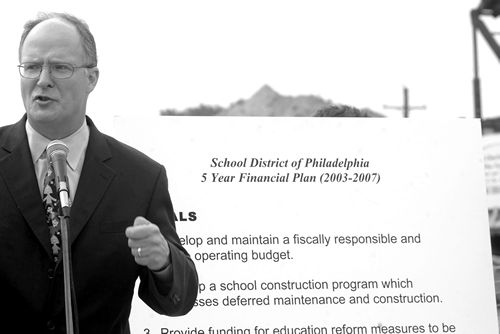 |
| Vallas’s insistence on strict accountability fits the Edison model well, but one never knows what will happen when new leadership tries to make its imprint on a school district. Photograph by the Associated Press.
|
At Ridge’s Invitation
More than 200,000 students attend the Philadelphia city schools, fewer than 20 percent of them non-Hispanic whites, 78 percent of them from families poor enough to qualify for federally subsidized school lunches. Just before Edison arrived in Philadelphia, the city government had tried to sue the state for more school funding. Mayor John F. Street eventually agreed to put aside the suit in return for negotiations between the city and the state, the state demanding reforms and the city in turn asking for more money to pay for them.
Street, an African-American lawyer who once taught at a city elementary school, is a veteran of Philadelphia’s racially tinged politics. Mayor Frank Rizzo was a lightning rod for racial tension in the 1980s. To the pres-ent day, politics in Philadelphia still tends to focus on issues of black and white more than in other cities–cities like New York and Los Angeles, where the massive inflow of Latino and Asian immigrants has created a more diverse political scene. But Street was a practical man, willing to overlook old battles if he could persuade the state to help and to defuse the feeling among many African-Americans in Philadelphia that the white power structure in Harrisburg was underfunding and discriminating against their schools.
His negotiations on the funding issue were with Pennsylvania governor Tom Ridge, a popular Republican who had beaten his Democratic opponent almost two to one in 1998. Ridge grew up in Erie and had been an infantryman in Vietnam. As governor, he proposed a voucher program for public school parents whose children were stuck in bad schools. His proposal won the support of some black Philadelphia legislators, but he could not overcome the resistance of the mainly Republican suburbs. Ridge did manage to persuade Street to sign a memorandum of understanding in July 2001 that gave him permission to order an analysis of the financial and educational condition of the school district. The state resisted giving the schools more funds when many observers thought the district was grossly mismanaging its finances and operations. It wanted some kind of assurance, backed by independent research, that any new money would be spent more effectively. Enter Edison Schools.
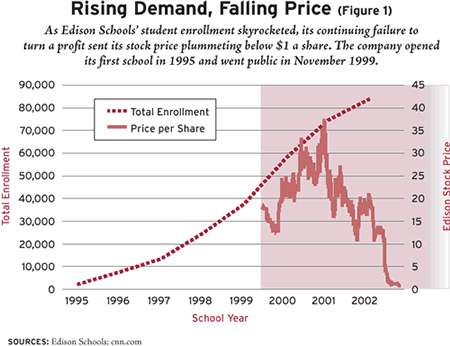 |
Rising Scores . . .
Ridge and his aides were impressed with Edison’s track record. Created in 1992 and starting its school management program in 1996, Edison had contracts to run more than 100 public schools. It was the brainchild of entrepreneur Christopher Whittle, whose controversial Channel One program had placed specially produced television news shows and advertising in public school homerooms.
Edison had gone further than any other private firm in demonstrating what business could do for the nation’s most impoverished children. Most of its schools were charter or contract schools, run independent of school district supervision but using tax dollars. Edison was educating some 85,000 students scattered across 23 states and the District of Columbia, making it the equivalent of the 45th-largest school district in the country (see Figure 1). Edison executives promised to save money and spread technological innovation by running those schools from a central administrative point. Many parents gravitated toward Edison as a fresh alternative to traditionally low-budget, low-tech inner-city schools. Schools like the Edison Friendship Public Charter School in Washington, D.C., had waiting lists from the moment they opened.
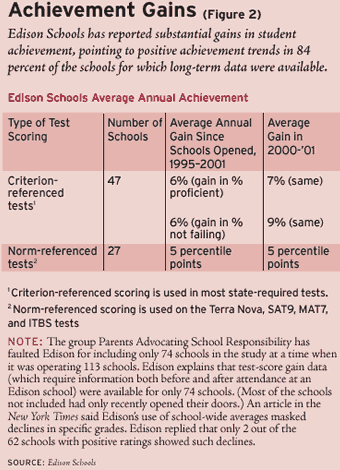 |
Just how successful Edison has been in raising student achievement remains a matter of debate (see Figure 2). John Chubb, Edison’s chief education officer, says that “student achievement is rising faster–much faster–in Edison schools than in any other similar system of schools in America.” Though critics dispute these numbers, there is little doubt that Edison has taken on significant challenges.
Edison’s portfolio is almost entirely made up of schools in distressed neighborhoods, areas with a demographic profile similar to that of the city of Philadelphia. About 70 percent of Edison students are poor enough to qualify for federal lunch subsidies, and more than 80 percent are black or Hispanic.
Edison officials say their schools are doing better because of innovative systems for hiring principals, checking student progress monthly, and teaching reading to older children. Edison schools use the Success For All system, which places students in small, well-paced, frequently tested groups for teaching reading. It gives home computers to students in the 3rd grade and up. It has longer school days and school years than ordinary public schools. Thomas Toch, a writer at the Washington-based National Center on Education and the Economy, praised innovations such as computer cameras for preliminary principal-hiring interviews and frequent dismissals of underperforming managers.
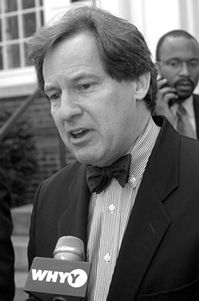 |
| The report Edison submitted to the state was a long list of Philadelphia’s failings. Fifty percent of Philadelphia students dropped out before graduating from high school. Here, Edison CEO Chris Whittle talks to reporters. Photograph by the Associated Press.
|
. . . But No Profits
If educational performance were the only yardstick, Edison would probably rank among the best urban school districts. But it has to please more than just parents and policymakers. Edison has to turn a profit, and its continuing failure to do so had pushed its stock price well below $1 a share by the end of August 2002 (see Figure 1).
Moreover, the teacher unions, whose members work in schools Edison is trying to manage, tend to bristle at the suggestion that a private company might make a profit on their turf, further complicating the company’s progress and provoking fervent protests in some cities. The demonstrations in Philadelphia began when Ridge announced in the summer of 2001 that he was awarding Edison a $2.7 million contract to study and make proposals for dealing with the financial and academic crisis in the Philadelphia schools.
The local union, the Philadelphia Federation of Teachers (PFT), repeated its long opposition to a state takeover and to any private companies running schools. There was also resistance from some students. Eric Braxton, the 26-year-old director of the Philadelphia Student Union, an organization of 4,000 politically active high-school students, began to organize marches and sit-ins. “Edison had a huge debt and they were trying to alleviate their difficulties by opening more schools,” he said. “We saw an inherent conflict of interest.”
Lois Yampolsky led parental opposition in northeast Philadelphia. Her neighbors were mostly white, middle-class Catholics and Jews, but she embraced the anti-Edison views of some African-American leaders in poorer parts of the city. “From the moment I read about Edison and its history,” she said, “I was determined to keep them out of the Philadelphia schools.” Edison officials said Yampolsky resisted their peace offerings. Adam Tucker, an Edison executive working on community relations, said she refused an invitation to visit an Edison school. “She said, ‘I am not going to a dog and pony show,’” Tucker said.
As expected, the report Edison submitted to the state was a long list of Philadelphia’s failings. Fifty percent of Philadelphia students dropped out before graduating from high school. In the past decade, the report said, the Philadelphia schools had spent more than $10 billion “with no clear accountability for the results.” The school district “finds itself overwhelmed with considerable, institutionalized issues across many critical functions, including a dizzying array of curricula with little centralized district control over them … and a poor and uncoordinated [information technology] system that leaves the District powerless to understand and use both student and educator performance data.”
The report was loudly denounced by Edison’s critics. “They pointed out everything they thought was being done poorly . . . and said they were the solution,” said U.S. representative Chaka Fattah, a former state legislator.
But Ridge, who praised the report, had unique leverage over the future of the Philadelphia schools. Under a law passed in 1998, the state could take over the city’s education system if it experienced any of a long list of financial problems, including a severe deficit. In the summer of 2001, Philadelphia schools were $215 million in the red, the result of long years of underfunding, according to city officials, or long years of mismanagement, according to their critics. The city had made up the difference with expense cuts and one-time revenue infusions. This left the city vulnerable to a determined move in Harrisburg, where the Republicans controlled the legislature.
Ridge was called to Washington to become President Bush’s homeland security advisor, but a plan for a state takeover of the city schools was already under way. Debra Kahn, Philadelphia’s secretary of education, said Street had three choices: 1) continue to go from crisis to crisis, 2) endure a hostile state takeover, or 3) form a partnership with the state to change the way the schools were run. Ridge was replaced by the lieutenant governor, Mark Schweiker, in October 2001. In December, Schweiker and Street agreed to the creation of the five-member School Reform Commission, which would replace the city school board. Three members would be appointed by Schweiker, two by Street.
 |
| Photograph courtesy of Edison Schools, Inc.
|
Commissioning Edison
Schweiker, a wealthy management consultant, was, from the very beginning of his governorship, a lame duck. He announced that he would not run in 2002 for a full term, a move that Edison’s opponents saw would make him less effective in fighting for Ridge’s plan.
Nonetheless, the new School Reform Commission had the authority to hire independent contractors to run the school system’s headquarters as well as individual schools. State officials had suggested that Edison might run the central office, but city groups–particularly the teacher union–were intensely opposed. For Edison to take over a system based on its own recommendation “was a clear conflict of interest,” said Barbara Goodman, a spokesperson for the PFT. Street said he thought the state was underestimating the challenge and overestimating Edison’s abilities. He set up an office at school headquarters and said he would not leave until the idea of Edison’s running the building was discarded. Schweiker bowed to the pressure, withdrawing the original proposal in exchange for Street’s agreement to let Edison be a consultant and run several schools.
With the political campaign against Edison in high gear, the School Reform Commission announced a compromise. Edison would get only half the number of schools it asked for, but more than any other private group. The commission identified 70 schools in need of special help, of which Edison would manage 20. Another 25 were assigned to two other for-profit companies and two universities. Twenty-one schools were to be restructured under the direction of a district team–an attempt to show what locals could do, just as Holmes did in Wichita–while four other schools were to be turned into charter schools.
Turning 20 schools over to Edison was a victory for advocates of school privatization. But it was a failure in the eyes of Wall Street, where the expectation was that Edison would receive 40 schools. Edison also suffered a series of blows to its financial image. The company accepted a Securities and Exchange Commission finding that it had improperly reported its receipt of money for teachers’ salaries and other expenses as revenue in 4 out of 62 contracts. In June, however, Edison announced that two financial institutions, Chelsey Capital and Merrill Lynch, had agreed to loan the company $40 million. (In August Edison said the deal had been revised, with Chelsey Capital being replaced as a lender by a new company, School Services Inc.)
 |
| Photograph courtesy of Edison Schools, Inc.
|
Community Relations
For local educators and parents, the events leading up to Edison’s arrival were traumatic. Truddie Kellam, who had both a child and a grandchild at Kenderton Elementary, said she had not liked the state takeover of the city schools. “I felt like we didn’t count,” she said. Kelley Elementary principal Mike Garafola had reacted viscerally to his school’s being placed on the list of 70 elementary and middle schools in need of special help. “It was like being kicked in the stomach,” he said. The school’s 400 children, 94 percent of them poor enough to qualify for federal lunch subsidies, scored far below national averages, but they had shown some improvement and Garafola resented the school’s getting no credit for that.
At a community meeting organized by Edison, Kellam asked many questions. She read the pamphlets, but they were too vague for her. She kept pushing and found herself appointed by Edison to the panel interviewing candidates for principal of the school. Like other parents, she had concerns about a private company taking over, but that was nothing compared with her frustration at the many failures of the past. “The problem is the children and their education,” she said. “Money has been spent and they still are not getting it.” So, she said, she was willing to give Edison a chance.
Among the Edison executives leading the community meetings were Holmes, from Wichita, and Ken Cherry, just arrived from Maryland. In Baltimore, Cherry had been a public school teacher and then an Edison academy director, partly responsible for one of the company’s most celebrated recent successes. The Maryland state school board had taken over three of Baltimore’s lowest-scoring elementary schools, Templeton, Gilmor, and Montebello, and given them to Edison. In April, just after the Philadelphia commission announced it was giving 20 schools to Edison, the Baltimore Sun reported big improvements in the Edison schools in Baltimore.
To make the same thing happen in Philadelphia, Edison officials said, they had to have the right principals. The company called an evening meeting at its temporary headquarters at the Buttonwood Hotel for the principals of the 20 schools it had been assigned. Garafola, who had been principal of Kelley Elementary since 1993, said the body language at the long table was unmistakable. “I could have written down how many would stay at Edison and how many would not,” he said. Some crossed their arms. Some turned their backs. But Garafola and others liked what they heard.
Several principals said they liked the fact that Edison promised to weave character education into every class. Holmes had seen how that had worked in Wichita. “A lot of the children we are working with are coming out of a culture of poverty that is very different from the culture of the middle-class world and the working world,” she said. “A lot of times teachers who come out of the middle-class world expect behaviors out of children that the children don’t even know they are expected to do because they haven’t been taught. So you just explain to them, hey, let me tell you … what you will do when you become an adult and go to the adult world.” By July, Edison knew that 8 of the 20 principals had agreed to stay at their schools, including Garafola.
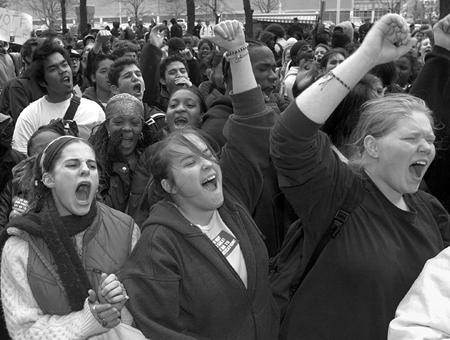 |
| “From the moment I read about Edison and its history,” said one parental opponent, “I was determined to keep them out of the Philadelphia schools.” Photograph by the Associated Press.
|
New Leadership
In July 2002 the commission named Vallas, a finance expert widely praised for his work as chief executive officer of the Chicago schools, as CEO of the Philadelphia schools. He squashed what remained of a proposal to have Edison also serve as a consultant to district headquarters for an additional $18 million to $24 million. “We don’t need a lead education consultant,” said Vallas, who signed a $225,000-a-year contract. “That’s what I’m here for.” Nonetheless, he promised to make sure the delicate arrangements between city and state would go forward, with Edison running more schools in Philadelphia than any other independent group.
The story of Edison in Philadelphia, however it works out, is likely to demonstrate two truths about improving schools. First, factors that have little to do with children are often very important. The strength of the PFT and its resistance to change, the desire to find a political compromise that would give all combatants some sense of victory, the vestiges of old battles over money and race, and Edison’s precarious financial status all had great influence over the number of schools Edison received and the initial support it had from teachers and parents.
Second, improvement in achievement is not going to be big or fast. Edison can point to overall gains and to recent increases in scores in Baltimore and Washington, D.C. Its critics can point to drops in Edison scores in some grades in a few cities. But few programs have succeeded in sustaining significant annual improvement in a significant number of schools for several years in a row. The most impressive rises in student achievement have occurred in isolated cases in a few schools–for instance, the Advanced Placement program at Garfield High School in East Los Angeles or the KIPP middle schools in Houston and the Bronx.
Holmes expects more though. “I came to work for Edison because I believe in their design and saw what a unique opportunity they had in Philadelphia,” Holmes said. “If they can prove that 20 schools can be reformed en masse, then why not an entire district?” When she first went to Colvin, the school in Wichita that bested Edison with Edison’s methods, “I would never have allowed my children to attend there,” she said. “Now many of the staff bring their children to Colvin. When the Philly schools are good enough for my children, we will have succeeded.”
-Jay Mathews covers education for The Washington Post.


